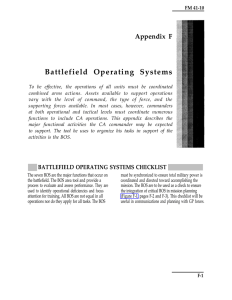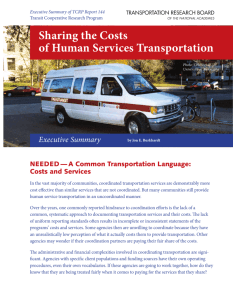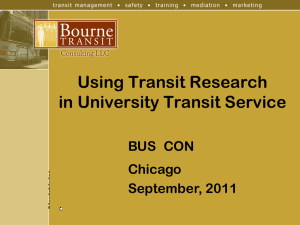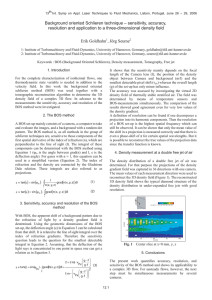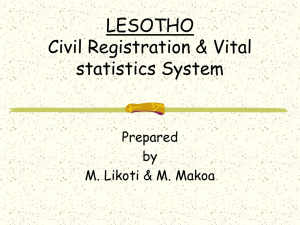A Guide for Implementing Bus On Shoulder (BOS) Systems
advertisement
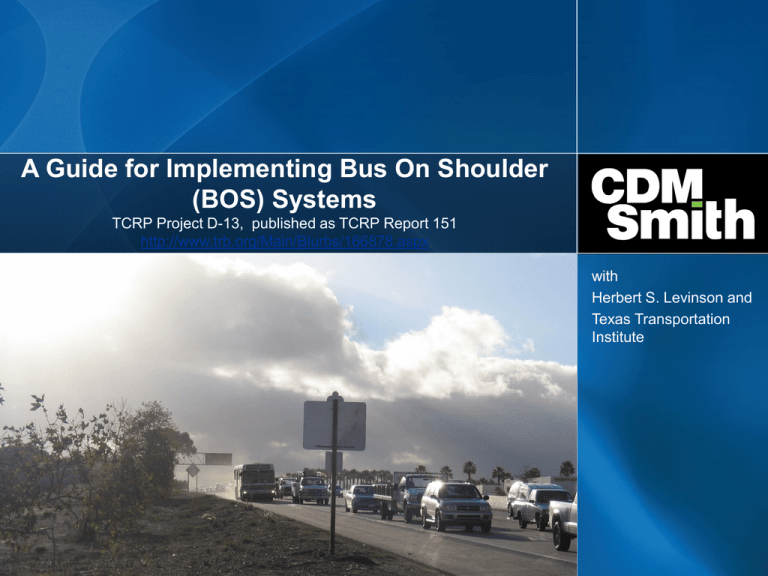
A Guide for Implementing Bus On Shoulder (BOS) Systems TCRP Project D-13, published as TCRP Report 151 http://www.trb.org/Main/Blurbs/166878.aspx with Herbert S. Levinson and Texas Transportation Institute PRESENTATION OVERVIEW • What is Bus On Shoulders (BOS)? • Where is it operating? • What are its implementation issues? • What are guidelines for implementing BOS? TCRP report 151 FORMS OF BUS ON SHOULDER CONCEPT • Applications – Comprehensive network – Corridor application – Queue jumper • Types – Interstate and freeways – Arterial streets – Both right shoulder and left shoulder applications TCRP Report 151 BUS ON SHOULDER EXAMPLES • San Diego freeway application • Twin Cities freeway and arterial network application • Virginia Dulles Access Road queue jump application • Left side shoulder applications – Cincinnati and Chicago • New Jersey arterial street application TCRP Report 151 SAN DIEGO BOS RIGHT SHOULDER TCRP Report 151 MINNEAPOLIS - ST PAUL BOS TCRP Report 151 MINNEAPOLIS - ST. PAUL BOS NETWORK TCRP Report 151 MINNEAPOLIS - ST. PAUL OPERATIONS • 35 MPH threshold speed • 15 MPH maximum delta speed • Buses yield to traffic at conflict points • Use shoulder only at driver’s discretion • 20 years experience • Nearly 300 miles of BOS • Team Transit website – www.dot.mn.us/metro/teamtransit TCRP Report 151 MNDOT TEAM TRANSIT WEBSITE VIDEO CLIPS http://www.dot.state.mn.us/metro/teamtransit/ TCRP Report 151 WEST FALLS CHURCH, VIRGINIA BOS • Eastbound queue jump on Route 267 in evening commute for priority access to the West Falls Church Transit Center connection to Metro • Allows buses to bypass freeway queue that builds for I-66 off-ramp from Route 267 • 1.3 miles in length with maximum speed of 25 mph • Congestion is substantial on Route 267 and the shoulder provides time savings of up to two minutes or more TCRP Report 151 WEST FALLS CHURCH STATION BOS QUEUE JUMPER TCRP Report 151 WEST FALLS CHURCH DULLES ACCESS ROAD SIGNAGE TCRP Report 151 CINCINNATI I-71 LEFT SHOULDER BOS TCRP Report 151 I-71 LEFT SHOULDER SIGNAGE TCRP Report 151 I-71 CINCINNATI BOS OPERATING PROTOCOLS Buses may use left shoulder when the following conditions are present: • Traffic: 30 mph or slower • 15 mph faster than traffic • No faster than 35 mph • 12 miles TCRP Report 151 CINCINNATI BOS FEATURES • 12 ft. shoulder • Center rumble strip • Good visibility • No exit/entrance ramp merging • Plenty of merge time • Wide ARTIMIS (Advanced Regional Traffic Interactive Management and Information System) coverage TCRP Report 151 NEW JERSEY ROUTE 9 BOS BEGIN SIGN TCRP Report 151 NEW JERSEY ROUTE 9 BOS MARKINGS TCRP Report 151 NEW JERSEY ROUTE 9 BOS MAINLINE SIGN TCRP Report 151 NEW JERSEY ROUTE 9 BOS END SIGN TCRP Report 151 NEW JERSEY ROUTE 9 BOS MARKINGS TCRP Report 151 NEW JERSEY ROUTE 9 NESTED BOS BUS STOP TCRP Report 151 BOS OPERATIONS - 2010 TCRP Report 151 MOST RECENT BOS IMPLEMENTATIONS • Kansas, I-70 freeway • Montreal, Highway 20 • North Carolina, I-40 Research Triangle (planned 2012 opening) • Chicago, I-55 Stevenson Expressway left side shoulder TCRP Report 151 TCRP SYNTHESIS 64 PROJECT PURPOSES • Identify the current state of the practice • Identify where BOS has been considered but not implemented TCRP SYNTHESIS 64 • Canvassing Survey – 24 MPOS – 17 Transit Operations – 25 DOTS • Six Case Studies – – – – – – Twin Cities Falls Church VA Miami-Dade San Diego Toronto Dublin TCRP SYNTHESIS 64 FINDINGS • Concept is successful – Expanding applications – None terminated • Popular with bus riders • Partnerships needed • Limited information available TCRP Report 151 TCRP REPORT 151 (PROJECT D-13) • Decision guidelines • Performance benefits • Transit operations guidelines • Design guidelines • Traffic integration guidelines • Update of case studies TCRP Report 151 DECISION MAKING PROCESS 1. Identify Need 2. Develop Concept Plan 3. Establish Multi-Agency BOS Team 4. Perform Feasibility Assessment 5. Develop Project Definition 6. Plan Implementation 7. Project Start-Up 8. Monitor Performance TCRP Report 151 STEP #1 IDENTIFY PROBLEM/NEED • Congestion related delays to bus operations • Congestion impacts on bus operating reliability • Congestion impacts on bus operating costs • Congestion impacts on market competitiveness TCRP Report 151 STEP #2 – DEVELOP CONCEPT PLAN • Draft Purpose and Need • Define BOS corridor and termini • Describe bus operating plan • Estimate preliminary travel time, reliability, and other benefits • Estimate person trip capacity throughput benefits for corridor • Provide info on successful similar BOS operations TCRP Report 151 STEP #3 – ESTABLISH MULTI AGENCY BOS TEAM • DOT departments • Transit operator staffs • MPO staffs • FHWA • Police • Local jurisdiction staffs TCRP Report 151 BOS TEAM INGREDIENTS FOR SUCCESS • Field visits to BOS operating sites – seeing is believing – Observations show the simplicity, safety, and benefits – Observations also help understand design and operational issues • Discussions with peers at BOS operating sites - peer to peer discussions help to allay concerns and identify important implementation issues • Finding the right persons for the BOS Team – Open and willing to find how to make BOS work – Authority to represent agency help find solutions TCRP Report 151 STEP #4 – PERFORM FEASIBILITY STUDY • Inventory shoulder widths and pinch points • Assess pavement strength • Assess drainage and other utility upgrade needs • Assess interchange weaving suitability • Identify traffic sight distance and safety concerns • Identify BOS maintenance needs • Identify legal restrictions • Determine the benefits of a pilot/demo approach TCRP Report 151 MIAMI DADE SHOULDER ASSESSMENT MAP TCRP Report 151 STEP #5 DEVELOP PROJECT DEFINITION • • • • • • • • • • BOS termini Width , signage, and markings improvements Pavement, rumble strip, and edge upgrades Cross slope improvements Utility upgrades/relocations BOS operating protocols Interchange weave strategies Legal basis Improvement costs Refine estimates of project benefits TCRP Report 151 STEP #6 PLAN IMPLEMENTATION • Execute appropriate interagency MOUs • Obtain required FHWA approvals • Establish legal authority • Perform environmental clearance studies • Obtain funding • Develop construction strategy to minimize impacts • Implement driver training program • Develop marketing and public info plan TCRP Report 151 STEP #7 PROJECT START-UP • Implement traffic advisory notice to motorists • Outreach to the media • Coordinate with enforcement agencies • Market benefits to riders TCRP Report 151 STEP #8 MONITOR PERFORMANCE • Driver and police feedback on adequacy of signs and markings • Monitor wear and ride quality of shoulders • Debrief drivers to identify refinements • Assess the time, reliability, and ridership of the project • Identify and implement refinements TCRP Report 151 POLITICALLY POPULAR TCRP Report 151 PERFORMANCE BENEFITS • Passenger benefits • Bus driver perceptions • Schedule reliability • Relative travel time savings TCRP Report 151 PASSENGER BENEFITS • Travel time savings is perceived at 2 to 3 times actual savings • Many riders enjoy bypassing slow traffic and encourage bus drivers to use the shoulder • Ridership gains are difficult to isolate from other factors TCRP Report 151 BUS DRIVER OPINIONS 100% 90% 80% 70% San Diego 60% Miami 50% Twin Cities Columbus 40% New Jersey 30% 20% 10% 0% Congestion is a Problem TCRP Report 151 Shortens Trip Improves Scehedule Times Good Idea SCHEDULE RELIABILITY AND TRAVEL TIME SAVINGS • Varies by day and BOS segment with the greatest benefits accruing during bad weather conditions • Travel time savings are highest for long segments and when congestions is most severe • Core bus trips during the peak hour achieve greater benefits than trips at the edge of the peak hour • Best quantifying approach is to measure current bus trip performance and compare to 35 mph BOS speeds TCRP Report 151 DESIGN GUIDELINES • Shoulder width & features • Interchange ramp Interfaces • Pavement structure • Drainage & utility modifications TCRP Report 151 TRANSIT OPERATIONS GUIDELINES • Threshold speed • Maximum delta speed • Driver training • Left versus right shoulder BOS TCRP Report 151 TRANSIT OPERATING PROTOCOLS • 35 mph BOS threshold for general traffic congestion and for maximum BOS speed has generally proven safe • Best to test each BOS application at 25 mph and 35 mph and solicit feedback from bus drivers on best speeds • Initial speeds can be easily adjusted based on operating experience and BOS drivers are advised only to operate at their discretion regarding speeds • 15 mph has generally proven safe regarding maximum speed delta between BOS and general traffic flow • MnDOT has an excellent driver training video TCRP Report 151 TRAFFIC GUIDELINES • Signage & striping • Ramp weaves • Auxiliary lanes • Ramp metering • Role for ITS • Police & emergency service TCRP Report 151 MN/DOT TYPICAL SHOULDER SIGNING PLAN FOR BUS ON SHOULDER USE (FREEWAY ONLY) TCRP Report 151 SHOULDER USE SIGNS Source: TCRP Synthesis 64 TCRP Report 151 ON RAMP SIGN Source: TCRP Synthesis 64 TCRP Report 151 MINNEAPOLIS BOS ON RAMP SIGNAGE TCRP Report 151 CINCINNATI VMS SIGN TCRP Report 151 RAMP WEAVING VOLUMES • Ramp metering can help break up on ramp platoons and provide gaps for BOS buses • Dual on and off ramps are generally problematic • Ramp volumes of less than 1,000 vph are generally not a problem for BOS weaves • Ramp volumes of 1,000 to 1,500 vph are worrisome but can sometimes work • Ramp volumes of 1,500 vph or higher are major concerns and buses probably should re-merge into general traffic at these interchanges TCRP Report 151 ADVANTAGES • Passenger Benefits – Reduced run times – Improved reliability – Market visibility – Station stopping service • Implementation – Low cost – Quick TCRP Report 151 BASIC REQUIREMENTS • Presence of buses – usually at least 4 per hour • Congestion on corridor highway • Minimum 10 foot wide shoulders • Avoidance of high volume entry and exit ramps (more than 1,000 vph) • Willingness of transit agencies, DOTs, and other stakeholders to work together • Ability to obtain FHWA approvals TCRP Report 151 CONCLUSIONS • Bus priority treatments have operated successfully for more than 50 years • Bus on Shoulder operations have more than 20 years of successful experience • Bus passengers save time and gain more reliable commute trips, while general traffic is unaffected • Safety experience has been excellent • Bus on shoulder operations are low cost and low impact means of improving corridor mobility TCRP Report 151 QUESTIONS? Peter Martin CDM Smith 201 Mission Street, Suite 1450 San Francisco, CA 94105 (415) 495-6201 MartinPC@cdmsmith.com TCRP Report 151

